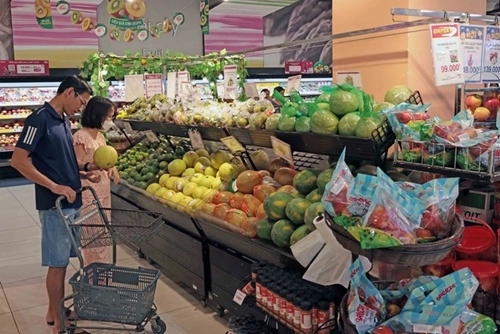On average, the CPI during the first four months of 2025 rose by 3.2% year-on-year, while core inflation went up 3.05%. The CPI growth was mainly driven by higher rental housing prices, food costs, and dining-out expenses.
    |
 |
|
People shop at a supermarket in Hanoi |
In April, prices rose in eight out of 11 groups of main consumer goods and services, two groups saw price declines, and one remained unchanged.
The food and catering services group had the biggest impact on the CPI as they rose 0.12% month-on-month, contributing 0.04 percentage point to the overall CPI growth. Within this group, food prices increased 0.17%, with pork prices rising 0.8% to push the CPI up by 0.03 percentage point.
The beverage and tobacco group also recorded a notable hike of 0.11% compared to March, driven by higher production costs and consumer demand. Apparel, headwear, and footwear prices increased 0.06% as demand picked up with the arrival of summer.
The group of housing, electricity, water, fuel, and construction materials posted the sharpest increase, by 0.62%, contributing 0.12 percentage point to the CPI expansion. Rental prices surged 0.57%, largely due to high real estate prices, which boosted rental demand. Additionally, rising costs for building materials, investment, and operations made landlords raise rents. Prices for housing maintenance materials also rose 0.62%, fuelled by higher import costs for sand, stone, steel, bricks, and tiles and public investment stimulus policies.
Gold prices surged in April, climbing 10.54% from the previous month and 37.14% year-on-year. The gold price index rose by 32.85% during January–April compared to the same period last year.
In contrast, the price of the US dollar moved against the global trend, mainly due to increased domestic demand. In April, the US dollar price index rose went up 0.97% month-on-month and 3.17% year-on-year, with a four-month average increase of 3.52%.
According to the NSO, major contributors to the four-month CPI hike included food and catering services, which rose by 3.86% year-on-year and contributed 1.3 percentage points to the overall CPI growth. Within this group, pork prices soared 13.46% due to limited supply and high demand during holidays, adding 0.46 percentage point to the CPI.
The housing, electricity, water, fuel, and construction materials group saw a price increase of 5.26%, mainly because of higher rental prices and input material costs, contributing 0.99 percentage point.
On the other hand, several factors helped curb the CPI upward trend. Most notably, the transport group declined 3.55%, reducing the CPI by 0.34 percentage point, primarily due to a 12.43% drop in fuel prices. The post and telecommunications services group also fell by 0.56%, lowering the CPI by 0.02 percentage point.
Source: VNA